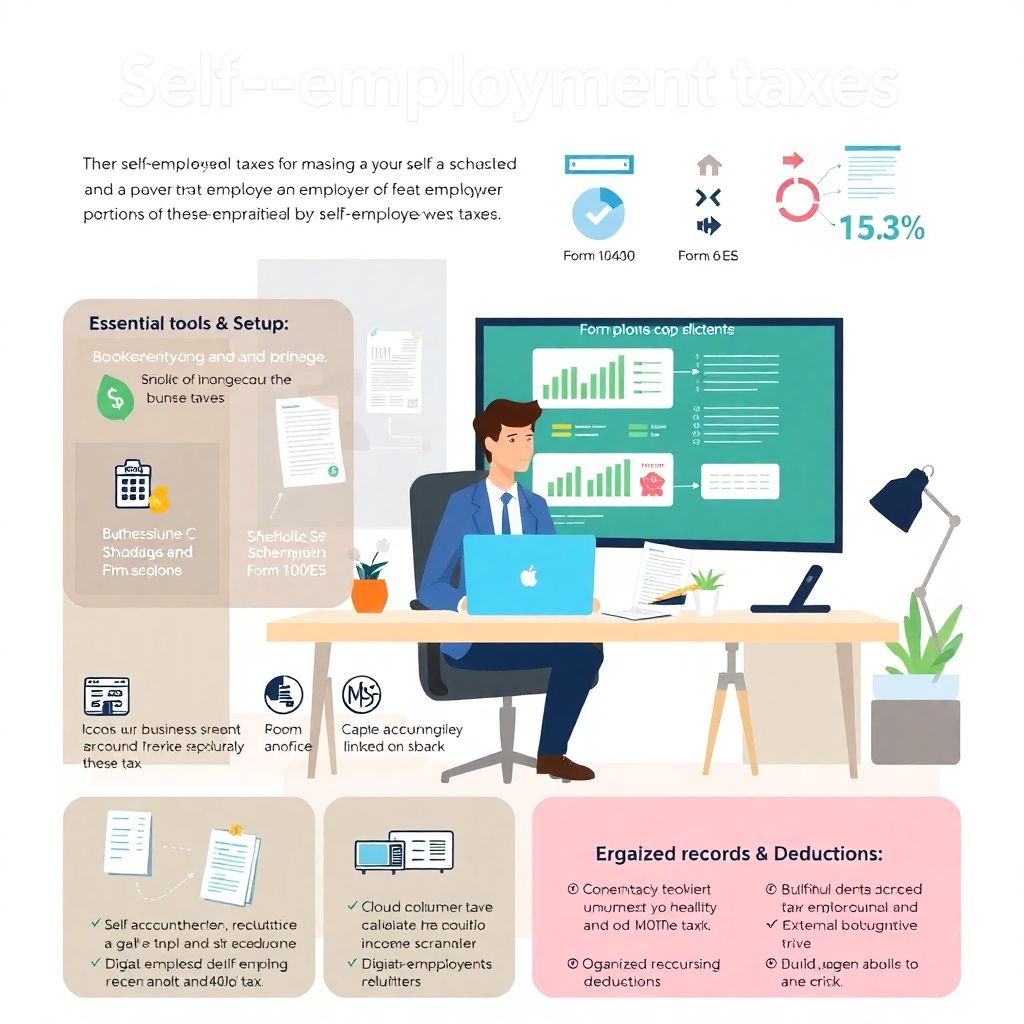Understanding Self-Employment Taxes in Practice
Self-employment tax is essentially how the government collects Social Security and Medicare contributions from people who don’t have an employer withholding them. Instead of your boss sending money to the IRS, you pay both the “employee” and “employer” share yourself, which is why the combined rate feels high. For many solo workers it comes out to 15.3% on most of your net profit, on top of income tax. When you see headlines about self employment tax rates 2025, they usually refer to this combined rate and the income cap for the Social Security portion. The core idea is simple: calculate profit, apply the rate, subtract allowed deductions, then square all of that with your regular income tax return.
Essential Tools and Setup

Before worrying about forms, make sure your toolkit is ready. At a minimum, you need a business bank account, a simple bookkeeping system, and a reliable self employment tax calculator to estimate what you owe during the year. Many people start with a spreadsheet, then outgrow it once income and expenses scale. That’s when the best tax software for self employed workers becomes useful: it can pull in 1099s, classify transactions, and auto-fill Schedule C and Schedule SE. A cloud accounting app that links to your bank will drastically cut down on manual work and reduce errors. Add a digital receipt tracker and a backup drive, and your basic compliance infrastructure is in place.
Building Your Records and Deductions

Clean records are what separate a smooth filing season from panic in March. Every payment and expense should be traceable through statements or invoices; “cash in an envelope” is basically begging for confusion. Think in categories that will later feed into your self employed tax deductions list: home office, supplies, software subscriptions, mileage, phone and internet, professional services, continuing education. A good habit is reviewing your books monthly and tagging each expense with a clear label and brief note, so you remember what it was five months later. When the IRS asks “how did you get this number?”, you want to click a few times and show supporting data, not spend a weekend reverse‑engineering your own finances from memory.
Step-by-Step: How to File Your Self-Employment Taxes
Let’s walk through how to file self employment taxes in a realistic way. Imagine Mia, a freelance UX designer. First she totals her client payments, then subtracts legitimate business expenses to get net profit. That number flows to Schedule C. From there, about 92.35% of her profit becomes the base for self‑employment tax on Schedule SE. The result is added to her income tax on Form 1040. During the year she makes quarterly estimated payments using Form 1040‑ES so she doesn’t get hit with penalties. Her accounting app projects those estimates automatically, based on current‑year income and last year’s return, which keeps her cash flow planning grounded in real numbers instead of guesswork.
Case Study: New Freelancer Shocked by Her First Tax Bill
Alex left a salaried tech job and went fully freelance in March. By December his bookkeeping showed $90,000 in revenue and $15,000 in expenses, so $75,000 in profit. He assumed he’d pay roughly the same tax as before and set aside around 20%. At filing time he discovered self-employment tax on top of income tax, because his old employer had previously covered half of Social Security and Medicare. The self-employment portion alone was over $10,000, and he hadn’t paid quarterly estimates. Result: a big balance due plus an underpayment penalty. The fix for next year was simple but strict: 30–35% of every client payment goes into a tax savings subaccount the moment it clears.
Case Study: Side Hustler With a Day Job
Jenna has a W‑2 day job and a weekend photography business. She thought the paycheck withholding “covered” everything, so she ignored the side income until tax season. Her software pulled in a 1099‑NEC for $18,000; after $4,000 of camera and travel costs, she had $14,000 of profit and a surprise self-employment tax bill. The good news: her regular withholding covered most of the income tax. The bad news: no one had been withholding for the self-employment piece. To avoid this going forward, she increased W‑2 withholding using a new W‑4 and started using a self employment tax calculator every quarter. That way she can decide whether to send 1040‑ES payments or just raise withholding as the side business grows.
Troubleshooting Common Problems
Most self-employed people run into the same issues: underestimating what they owe, mixing personal and business spending, and missing obvious deductions. If your first run through tax software shows a balance due far higher than expected, don’t panic—drill into the schedules. Confirm that all expenses were entered, especially mileage, home office, and health insurance if you pay it yourself. Compare your entries with a self employed tax deductions list from a reputable source and see what you legitimately missed. If transactions are jumbled together in one account, spend the time to separate and reclassify them; the tax savings and audit protection usually justify the cleanup effort. If numbers still look off, that’s when a one‑hour session with a CPA can be money well spent.
Avoiding Future Headaches

Once you’ve survived one season, turn it into a repeatable process. Block a monthly “finance hour” to reconcile accounts, review profit, and forecast taxes. Recheck official IRS guidance each year, especially around any updates tied to self employment tax rates 2025 and beyond, so that your estimates stay accurate. Most modern apps let you save report presets, so you can run the same profit‑and‑loss and tax estimate views with two clicks. If your situation becomes more complex—forming an LLC, hiring contractors, selling digital products across states—consider upgrading from DIY tools to a hybrid model where an accountant reviews your files annually. The goal isn’t perfection; it’s a system that reliably catches issues early, long before a big bill or notice shows up.

